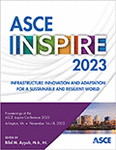Integrated Framework for Bridge Crack Detection and Semantic BIM Model Generation Using Drone-Captured Imagery and Deep Learning Techniques
Publication: ASCE Inspire 2023
ABSTRACT
Concrete cracking in bridges significantly endangers their safety and integrity. Traditional crack detection methods, reliant on human visual inspection, are labor-intensive and prone to errors. This paper introduces a unique framework for bridge crack detection and integration with building information models (BIM), trialed on a 423-ft bridge in Atlanta, Georgia. The framework comprises two main stages: (1) creating a BIM model using drone-captured images and structure from motion (SFM) photogrammetry, and (2) utilizing a deep learning-based encoder-decoder network to segment bridge cracks from orthomosaic images and superimpose these segmented cracks onto the BIM model. The suggested method showed robust performance, achieving a mean intersection over union (mIoU) of 0.787, precision of 0.751, and recall of 0.742. These results underline the potential of the proposed framework to improve the efficiency of bridge crack inspection processes.
Get full access to this article
View all available purchase options and get full access to this chapter.
REFERENCES
Abdelkhalek, S., and T. Zayed. 2020. “Comprehensive Inspection System for Concrete Bridge Deck Application: Current Situation and Future Needs.” Journal of Performance of Constructed Facilities, 34 (5): 03120001. https://doi.org/10.1061/(ASCE)CF.1943-5509.0001484.
ASCE. 2021. “America’s Infrastructure Report Card 2021.” American Society of Civil Engineers. Accessed April 8, 2023. https://infrastructurereportcard.org/cat-item/bridges-infrastructure/.
Dorafshan, S., and M. Maguire. 2018. “Bridge inspection: human performance, unmanned aerial systems and automation.” J Civ Struct Health Monit, 8 (3): 443–476. Springer. https://doi.org/10.1007/s13349-018-0285-4.
Hu, D., and S. Li. 2022. “Recognizing object surface materials to adapt robotic disinfection in infrastructure facilities.” Computer-Aided Civil and Infrastructure Engineering, 37 (12): 1521–1546. Wiley Online Library. https://doi.org/10.1111/mice.12811.
Hu, D., S. Li, J. Du, and J. Cai. 2023a. “Automating Building Damage Reconnaissance to Optimize Drone Mission Planning for Disaster Response.” Journal of Computing in Civil Engineering, 37 (3): 04023006. American Society of Civil Engineers. https://doi.org/10.1061/(ASCE)CP.1943-5487.0001061.
Hu, D., S. Li, and M. Wang. 2023b. “Object detection in hospital facilities: A comprehensive dataset and performance evaluation.” Eng Appl Artif Intell, 123: 106223. https://doi.org/https://doi.org/10.1016/j.engappai.2023.106223.
Hu, D., H. Zhong, S. Li, J. Tan, and Q. He. 2020. “Segmenting areas of potential contamination for adaptive robotic disinfection in built environments.” Build Environ, 184: 107226. Elsevier Ltd. https://doi.org/10.1016/j.buildenv.2020.107226.
Li, G., X. Li, J. Zhou, D. Liu, and W. Ren. 2021. “Pixel-level bridge crack detection using a deep fusion about recurrent residual convolution and context encoder network.” Measurement, 176: 109171. Elsevier. https://doi.org/10.1016/j.measurement.2021.109171.
Omer, M., L. Margetts, M. H. Mosleh, and L. S. Cunningham. 2021. “Inspection of Concrete Bridge Structures: Case Study Comparing Conventional Techniques with a Virtual Reality Approach.” Journal of Bridge Engineering, 26 (10): 05021010 . American Society of Civil Engineers. https://doi.org/10.1061/(ASCE)BE.1943-5592.0001759.
Ronneberger, O., P. Fischer, and T. Brox. 2015. “U-Net: Convolutional Networks for Biomedical Image Segmentation.” International Conference on Medical image computing and computer-assisted intervention, 234–241. Springer Verlag.
Teng, S., Z. Liu, and X. Li. 2022. “Improved YOLOv3-based bridge surface defect detection by combining High-and low-resolution feature images.” Buildings, 12 (8): 1225. MDPI. https://doi.org/10.3390/buildings12081225.
Yang, G., K. Liu, J. Zhang, B. Zhao, Z. Zhao, X. Chen, and B. M. Chen. 2022. “Datasets and processing methods for boosting visual inspection of civil infrastructure: A comprehensive review and algorithm comparison for crack classification, segmentation, and detection.” Constr Build Mater, 356: 129226. Elsevier. https://doi.org/10.1016/j.conbuildmat.2022.129226.
Zhang, L., J. Shen, and B. Zhu. 2021. “A research on an improved Unet-based concrete crack detection algorithm.” Struct Health Monit, 20 (4): 1864–1879. SAGE Publications Sage UK: London, England. https://doi.org/10.1177/1475921720940068.
Information & Authors
Information
Published In
History
Published online: Nov 14, 2023
ASCE Technical Topics:
- Architectural engineering
- Artificial intelligence and machine learning
- Bridge engineering
- Bridges
- Bridges (by material)
- Building information modeling
- Building management
- Computer programming
- Computing in civil engineering
- Concrete bridges
- Construction engineering
- Construction management
- Continuum mechanics
- Cracking
- Engineering fundamentals
- Engineering mechanics
- Fracture mechanics
- Infrastructure
- Infrastructure resilience
- Inspection
- Models (by type)
- Neural networks
- Solid mechanics
- Structural engineering
- Structural models
Authors
Metrics & Citations
Metrics
Citations
Download citation
If you have the appropriate software installed, you can download article citation data to the citation manager of your choice. Simply select your manager software from the list below and click Download.
